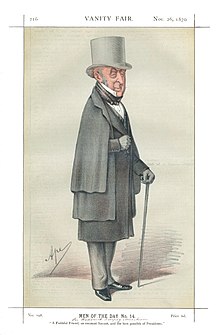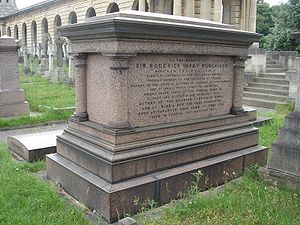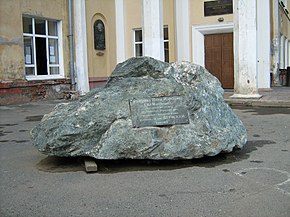Roderick Murchison
Roderick Murchison | |
|---|---|
 Sir Roderick Murchison | |
| Born | 19 February 1792 Tarradale House,Muir of Ord,Ross-shire,Scotland |
| Died | 22 October 1871(aged 79) London, England |
| Nationality | Scottish |
| Known for | Siluriansystem Devoniansystem Permiansystem |
| Spouse | |
| Awards | Copley Medal(1849) Makdougall Brisbane Prize(1859) Wollaston Medal(1864) Founder's Medal(1871) |
| Scientific career | |
| Fields | Geology |
| Signature | |


Sir Roderick Impey Murchison, 1st Baronet,KCB,DCL,FRS,HonFRSE,FLS,MRIA(19 February 1792 – 22 October 1871[1]) was a Scottishgeologistwho served asdirector-generalof theBritish Geological Surveyfrom 1855 until his death in 1871. He is noted for investigating and describing theSilurian,[2]DevonianandPermiansystems.
Early life and work[edit]
Murchison was born atTarradale House,Muir of Ord,Ross-shire,the son of Barbara and Kenneth Murchison. His wealthy father died in 1796, when Roderick was four years old, and he was sent toDurham Schoolthree years later[3]and then to theRoyal Military College, Great Marlow,to be trained for the army. In 1808 he landed withWellesleyin Portugal, and was present at the actions ofRoliçaandVimeiroin thePeninsular Waras an ensign in the36th Regt of Foot.Subsequently, under SirJohn Moore,he took part in the retreat toCorunnaand the final battle there.
After eight years of service Murchison left the army and marriedCharlotte Hugonin(1788–1869), the only daughter of General Hugonin of Nursted House, Hampshire. Murchison and his wife spent two years in mainland Europe, particularly in Italy. They then settled inBarnard Castle,County Durham, England, in 1818, where Murchison made the acquaintance of SirHumphry Davy.Davy urged Murchison to turn his energy to science, after hearing that he wasted his time riding to hounds and shooting. With encouragement from his wife Charlotte,[4]Murchison became fascinated by the young science of geology and joined theGeological Society of London,soon becoming one of its most active members. His colleagues there includedAdam Sedgwick,William Conybeare,William Buckland,William Fitton,Charles LyellandCharles Darwin.
Exploring with his wife, Murchison studied the geology of the south of England, devoting special attention to the rocks of the north-west ofSussexand the adjoining parts ofHampshireandSurrey,on which, aided by Fitton, he wrote his first scientific paper, read to the Geological Society of London in 1825. Turning his attention to Continental geology, he and Lyell explored the volcanic region ofAuvergne,parts of southern France, northern Italy,Tyroland Switzerland. A little later, with Sedgwick as his companion, Murchison attacked the difficult problem of the geological structure of theAlps.Their joint paper giving the results of their study is a classic in the literature of Alpine geology.
Murchison was an opponent ofCharles Darwin's theory of evolution. He opposed thetransmutation of speciesand supportedsuccessive creation.[5][6]
Silurian system[edit]
In 1831 he went to theEngland–Wales border,to attempt to discover whether thegreywackerocks underlying theOld Red Sandstonecould be grouped into a definite order of succession. The result was the establishment of theSiluriansystem under which were grouped, for the first time, a remarkable series of formations, each replete with distinctive organic remains other than and very different from those of the other rocks of England. These researches, together with descriptions of thecoalfieldsand overlying formations inSouth Walesand theEnglish border counties,were embodied inThe Silurian System(1839). The English naturalist, geologist, and palaeontologistJohn William Salterassisted Murchison in his work on Siluria (1854 and later editions).[7]
The establishment of the Silurian system was followed by that of theDevoniansystem, an investigation in which Murchison assisted, both in the south-west of England and in theRhineland.Soon afterwards Murchison projected an important geological campaign in Russia with the view of extending to that part of the Continent the classification he had succeeded in elaborating for the older rocks of western Europe. He was accompanied byÉdouard de Verneuil(1805–1873) and CountAlexander von Keyserling(1815–1891), in conjunction with whom he produced a work on Russia and theUral Mountains.The publication of this monograph in 1845 completes the first and most active half of Murchison's scientific career. He was elected a Foreign Honorary Member of theAmerican Academy of Arts and Sciencesin 1840.[8]
In 1846 he was knighted, and in the same year he presided over the meeting of theBritish AssociationatSouthampton.During the later years of his life, a large part of his time was devoted to the affairs of theRoyal Geographical Society,of which he was in 1830 one of the founders,[9]and he was president 1843–1845, 1851–1853, 1856–1859 and 1862–1871. He served on theRoyal Commission on the British Museum(1847–1849).[10]
Murchison alsoannounced the Permian systemto geology in 1841, based on explorations inPerm Kraiundertaken with Édouard de Verneuil.[11][12]
Murchison was responsible for establishing much of the international prestige of British geology, and he viewed the spread of his stratigraphic systems on maps around the world "as a scientific form of imperial expansion". He frequently described geological excursions (such those he made abroad) as "invasions" or "conquests" and enjoyed being dubbed the "King of Siluria". According to the scholar Robert A. Stafford, "Murchinson's tendencies towardsmilitarism,imperialism,andmegalomaniaran through his career and finally found full expression his simultaneous leadership of the Royal Geographical Society and the British Geological Survey. "[13]
Scotland[edit]

The chief geological investigation of the last decade of his life was devoted to theHighlandsof Scotland, where he wrongly believed he had succeeded in showing that the vast masses of crystallineschists,previously supposed to be part of what used to be termed the Primitive formations, were really not older than the Silurian period, since underneath them lay beds oflimestoneandquartzitecontaining Lower Silurian (Cambrian)fossils.This started off what became known as theHighlands Controversy.James Nicolrecognised the fallacy in Murchison's theory and propounded his own ideas; in the 1880s these were superseded by the correct theory ofCharles Lapworth,which was corroborated byBenjamin PeachandJohn Horne.Their subsequent research showed that the infraposition of the fossiliferous rocks is not their original place, but had been brought about by a gigantic system of dislocations, whereby successive masses of the oldestgneisses,have been exhumed from below and thrust over the younger formations.
In 1855 Murchison was appointed director-general of theBritish Geological Surveyand director of theRoyal School of Minesand theMuseum of Practical Geologyin Jermyn Street, London, in succession to SirHenry De la Beche,who had been the first to hold these offices. Official routine now occupied much of his time, but he found opportunity for the Highland researches just alluded to, and also for preparing successive editions of his workSiluria(1854, ed. 5, 1872), which was meant to present the main features of the original Silurian System together with a digest of subsequent discoveries, particularly of those that showed the extension of the Silurian classification into other countries.
Later life[edit]


In 1845, whilst visitingCarclewinCornwall,he met severalCornishminers who were going to Australia. Believing that there might be gold there, he asked them to send back likely samples. They did this, and thus Murchison knew of the existence of gold in Australia beforeEdward Hargraves' discovery.[14] In 1857, Murchison was elected a member of theAmerican Antiquarian Society.[15]Three years later, he was elected to theAmerican Philosophical Society.[16]
In 1863 he was made aKCB,and three years later he was created abaronet.The learned societies of his own country bestowed their highest rewards upon him: theRoyal Societygave him theCopley Medal,the Geological Society itsWollaston medal,and theRoyal Society of Edinburghits Brisbane Medal. There was hardly a foreign scientific society of note without his name among its honorary members. TheFrench Academy of Sciencesawarded him the prix Cuvier, and elected him one of its eight foreign members in succession toMichael Faraday.In 1855 he was elected a foreign member of theRoyal Swedish Academy of Sciencesand in 1871 awarded theFounders' Medalof the Royal Geographical Society.[17]
One of the closing public acts of Murchison's life was the founding of a chair of geology and mineralogy at theUniversity of Edinburgh.Under his will there was established theMurchison Medaland a geological fund (The Murchison Fund) to be awarded annually by the council of the Geological Society in London.
Murchison died in 1871 and is buried inBrompton Cemetery,London, near the north end of the arcade on the west side of the central path.
Legacy[edit]
The craterMurchisonon theMoonand at least fifteen geographical locations on Earth are named after him.
These include: the Murchison Range, part of theStauning Alps,and theMurchison SoundinGreenland;[18]Mount MurchisoninBanff National Park,Canada; Mount Murchison in theMountaineer Range,Antarctica; Mount Murchison, just west ofSquamish, British Columbia,Canada; tiny Murchison Island inHaida Gwaiiin the same province; theMurchison Fallsin Uganda; theMurchison Riverin Western Australia.[19]Murchison has two other rivers named after him in Western Australia: the Roderick River and theImpey River,both tributaries of the Murchison. The town ofMurchisonin the Tasman Region of New Zealand's South Island was also named after him. Murchison Road is one of the streets in east London, and there is a Murchison Avenue in Old Bexley, southeast London. Scarborough in North Yorkshire has a Murchison Street.

Murchison's View is named after him. The viewpoint within the Wren's Nest area ofDudleygives a panoramic view over much of Birmingham and the Black Country. Murchinson's visits to the limestone hills of Dudley helped him to develop his understanding of the Silurian System. When he returned to the area in 1849 he was greeted by 15,000 locals who declared him the King of Siluria.
Memorials[edit]

A memorial tablet was installed on 3 November 2005 in front of School #9 inPermin Russia.[20]It consists of a stone base, irregular in form, about two metres long, and bearing a dark stone plate with the following inscription (in Russian):
To Roderick Impey Murchison, Scottish geologist, explorer ofPerm Krai, who gave to the last period of the Paleozoic era the name of Permian.
The decision to perpetuate the explorer's name was accepted by the school administration and pupils in connection with a discussion to establish in Perm a pillar or an arch devoted to Roderick Murchison.
In 2009, the Ural-Scottish Society erected a memorial to Murchison on the banks of theChusovaya River.[21]There is a commemorativeblue plaqueon his residence at 21 Galgate inBarnard Castle(County Durham).
A fictionalised version of Murchison appears in the 2020 filmAmmonite.He is played byJames McArdle.
Bibliography[edit]
- Outline of the Geology of the Neighbourhood of Cheltenham.H. Davies. 1834.
- The Silurian System.London: John Murray. 1839.
- On the Geological Structure of the Central and Southern Regions of Russia in Europe, and of the Ural Mountains.Print. by R. and J.E. Taylor. 1842.
- Geology of Russia in Europe and the Ural Mountains.Vol. 1: Parts 1 & 2 – Geology. 1845.with Edouard de Verneuil and Count Alexander Keyserling
- Géologie de la Russie d'Europe et des montagnes de l'Oural[Geology of Russia in Europe and the Ural Mountains] (in French). Vol. 2: Part 3 – Palaeontology. Paris: P. Bertrand. 1845.
References[edit]
Notes[edit]
- ^"Murchison, Sir Roderick Impey, baronet".Oxford Dictionary of National Biography(online ed.). Oxford University Press.doi:10.1093/ref:odnb/19555.(Subscription orUK public library membershiprequired.)
- ^Geikie 1911,pp. 31–32.
- ^Bonney, T. G.; Stafford, The Revd Robert A. "Murchison, Sir Roderick Impey, baronet (1792–1871)".Oxford Dictionary of National Biography(online ed.). Oxford University Press.doi:10.1093/ref:odnb/19555.
In 1799 Roderick was placed at the grammar school, Durham, where he led in mischief more often than in his class.
(Subscription orUK public library membershiprequired.) - ^Kölbl-Ebert, Martina (January 1997). "Charlotte Murchison (Née Hugonin) 1788–1869".Earth Sciences History.16(1): 39–43.Bibcode:1997ESHis..16...39K.doi:10.17704/eshi.16.1.97014235w8u4k414.ISSN0736-623X.
- ^Geikie 1875,pp. 321–322.
- ^Branch 2016.
- ^MURCHISON, R. I. 1854. Siluria. The History of the Oldest known Rocks containing Organic Remains, with a Brief Sketch of the Distribution of Gold over Earth. John Murray, London, 523 pp.
- ^"Book of Members, 1780–2010: Chapter M"(PDF).American Academy of Arts and Sciences.Retrieved15 September2016.
- ^Markham, Sir Clements Robert (1881).The Fifty Years' Work of the Royal Geographical Society.J. Murray. p. 23.
- ^Fagan 1880,p. 257.
- ^Benton, M.J. et al.,Murchison’s first sighting of the Permian, at Vyazniki in 1841Archived2012-03-24 atWebCite,Proceedings of the Geologists' Association, accessed 2012-02-21
- ^Murchison, Roderick Impey (1841)"First sketch of some of the principal results of a second geological survey of Russia,"Philosophical Magazine and Journal of Science,series 3,19:417–422. From p. 419: "The carboniferous system is surmounted, to the east of the Volga, by a vast series of marls, schists, limestones, sandstones and conglomerates, to which I propose to give the name of" Permian System, "…."
- ^Stafford, Robert A. (1984)."Geological surveys, mineral discoveries, and British expansion, 1835–71".The Journal of Imperial and Commonwealth History.12(3): 5–32.doi:10.1080/03086538408582669.
- ^Bonython, John Langdon(1933–34), "Address of the President",Journal of the Royal Institution of Cornwall,vol. XXIV, Parts 1 and 2, p. 5
- ^"Members Directory".American Antiquarian Society.
- ^"APS Member History".search.amphilsoc.org.Retrieved15 January2021.
- ^"List of Past Gold Medal Winners"(PDF).Royal Geographical Society. Archived fromthe original(PDF)on 27 September 2011.Retrieved24 August2015.
- ^"Catalogue of place names in northern East Greenland"(PDF).Geological Survey of Denmark. Archived fromthe original(PDF)on 30 December 2016.Retrieved30 December2016.
- ^"BCGNIS listing" Mount Murchison "".Archived fromthe originalon 15 August 2007.Retrieved9 June2008.
- ^Chernov, Nikita (21 October 2015)."Школьники установили памятный знак геологу, открывшему Пермский период Палеозоя"[School pupils established a memorial to the geologist who discovered the Permian period of Paleozoic Era] (in Russian). Archived fromthe originalon 11 March 2007.Retrieved27 March2017.
- ^"A memorial to Sir Roderick Impey Murchison, the Scottish geologist who established the Permian archaeological period of the Mesozoic Era, has been unveiled on the bank of the Chusovaya River in the Ural Mountains".The Daily Telegraph.24 February 2009. Archived fromthe originalon 21 August 2009.Retrieved27 March2010.
- ^International Plant Names Index.Murch.
Sources[edit]
- Fagan, Louis (1880).The Life of Sir Anthony Panizzi, K. C. B.: Late Principal Librarian of the British Museum, Senator of Italy, &c., &c.Vol. 1. Boston: Houghton.
- Branch, Glenn (2016)."Misquoting Murchison".National Center for Science Education.
- Geikie, Archibald (1875).Life of Sir Roderick I. Murchison: Based on His Journals and Letters.Vol. 2. London: John Murray.
- Geikie, Archibald(1911)..InChisholm, Hugh(ed.).Encyclopædia Britannica.Vol. 19 (11th ed.). Cambridge University Press. pp. 31–32.
Further reading[edit]
- Geikie, Archibald(1875).Life of Sir Roderick I. Murchison.Vol. I. London: John Murray.Retrieved26 February2019– via Internet Archive.
- Geikie, Archibald(1875).Life of Sir Roderick I. Murchison.Vol. II. London: John Murray.Retrieved26 February2019– via Internet Archive.
- Hestmark, Geir (2008). "A primitive country of rocks and people" – Roderick I Murchison's Silurian Campaign in Norway 1844 ".Norwegian Journal of Geology.88:117–141.
- Morton, John L. (2004).King of Siluria — How Roderick Murchison Changed the Face of Geology.Brocken Spectre.ISBN0-9546829-0-4.
- Rudwick, Martin J. S.(1985).The Great Devonian Controversy: The Shaping of Scientific Knowledge among Gentlemanly Specialists.University of Chicago Press.ISBN9780226731018.— the rise of Murchison to power
- Secord, James A.(1986).Controversy in Victorian Geology: The Cambrian-Silurian Dispute.Princeton University Press.— documents the battle between Murchison andAdam Sedgwick
- Collie, M.; Diener, J., eds. (2004),Murchison's Wanderings in Russia: His Geological Exploration of Russia in Europe and the Ural Mountains, 1840–1841,British Geological Survey Occasional Publication No. 2., Buckinghamshire: Halstan & Co., p. 474
- Murchison, Arthur (2014).War Before Science: Sir Robert Impey Murchison's Youth, Army Service and Military Associates During the Napoleonic Wars.Academica Press.ISBN978-1-936320-74-5.
- Stafford, Robert A. (1989).Scientist of Empire: Sir Roderick Murchison, Scientific Exploration and Victorian Imperialism.Cambridge University Press.- documents Murchison's role in promoting the symbiotic relationship between the natural sciences and British imperialism
- "Sir Roderick Murchison (Obituary Notice, Monday, October 23, 1871)".Eminent Persons: Biographies reprinted from The Times.Vol. I (1870–1875). London: Macmillan and Co. 1892. pp. 63–75.hdl:2027/uc2.ark:/13960/t6n011x45.
External links[edit]
- 1792 births
- 1871 deaths
- 19th-century British geologists
- 19th-century Scottish scientists
- Academics of the University of Edinburgh
- Baronets in the Baronetage of the United Kingdom
- British creationists
- Burials at Brompton Cemetery
- Fellows of the American Academy of Arts and Sciences
- Fellows of the Linnean Society of London
- Fellows of the Royal Society
- Fellows of the Royal Society of Edinburgh
- Foreign associates of the National Academy of Sciences
- Full members of the Saint Petersburg Academy of Sciences
- Graduates of the Royal Military College, Great Marlow
- Honorary members of the Saint Petersburg Academy of Sciences
- Knights Commander of the Order of the Bath
- Members of the American Antiquarian Society
- Members of the French Academy of Sciences
- Members of the Prussian Academy of Sciences
- Members of the Royal Danish Academy of Sciences and Letters
- Members of the Royal Irish Academy
- Members of the Royal Swedish Academy of Sciences
- People associated with the British Museum
- People educated at Durham School
- People from Barnard Castle
- People from the Black Isle
- Presidents of the Geological Society of London
- Presidents of the Royal Geographical Society
- Recipients of the Copley Medal
- Scottish geologists
- Scottish palaeontologists
- Scottish soldiers
- Wollaston Medal winners
- Committee members of the Society for the Diffusion of Useful Knowledge
- Directors of the British Geological Survey

